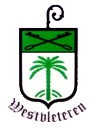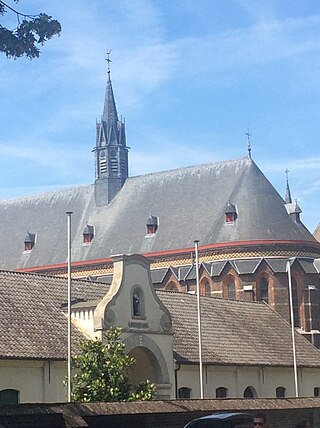
Kontich is a municipality located in the Belgian province of Antwerp. The municipality comprises the towns of Kontich proper and Waarloos. In 2021, Kontich had a total population of 21,260. The total area is 23.67 km³.

Malle is a municipality located in the Campine region of the Belgian province of Antwerp. The municipality comprises the villages of Oostmalle and Westmalle. In 2021, Malle had a total population of 15,620. The total area is 51.99 km2.

Trappist beer is brewed by Trappist monks. Thirteen Trappist monasteries—six in Belgium, two in the Netherlands, and one each in Austria, Italy, England, France, and Spain—currently produce beer, but the Authentic Trappist Product label is assigned by the International Trappist Association (ITA) to just ten breweries which meet their strict criteria. As of 2021, Achel is no longer recognized as a Trappist brewery because it does not have any living monks.

Westvleteren is a brewery founded in 1838 at the Trappist Abbey of Saint Sixtus in Vleteren, Belgium.

Achel Brewery or Brouwerij der Sint-Benedictusabdij de Achelse Kluis was a Belgian Trappist brewery, until January 2021. It continues to operate as a brewery but is no longer Trappist, as the brewing monks whose presence gave rise to that status have retired. It is located in the Abbey of Saint Benedict in the Belgian municipality of Hamont-Achel. It brews six "Trappist beers".

Rochefort Brewery is a Belgian brewery which produces four beers designated as Trappist beers. The brewery is associated with the Rochefort Abbey, a Trappist monastery which originated in the 13th century. The current brewery dates from 1899.

Westmalle Brewery is a Trappist brewery in the Westmalle Abbey, Belgium. It produces three beers, designated as Trappist beer by the International Trappist Association. Westmalle Tripel is credited with being the first golden strong pale ale to use the term Tripel.

Beer in Belgium includes pale ales, lambics, Flemish red ales, sour brown ales, strong ales and stouts. In 2018, there were 304 active breweries in Belgium, including international companies, such as AB InBev, and traditional breweries including Trappist monasteries. On average, Belgians drink 68 liters of beer each year, down from around 200 each year in 1900. Most beers are bought or served in bottles, rather than cans, and almost every beer has its own branded, sometimes uniquely shaped, glass. In 2016, UNESCO inscribed Belgian beer culture on their list of the intangible cultural heritage of humanity.
The term dubbel is a Belgian Trappist beer naming convention. The origin of the dubbel was a strong version of a brown beer brewed in Westmalle Abbey in 1856, which is known to have been on sale to the public by June 1861. In 1926, the recipe was changed, and it was sold as Dubbel Bruin. Following World War Two, abbey beers became popular in Belgium and the name "dubbel" was used by several breweries for commercial purposes.

De Koningshoeven Brewery (Brouwerij de Koningshoeven) is a Dutch Trappist brewery founded in 1884 within the walls of Koningshoeven Abbey (Abdij Onze Lieve Vrouw van Koningshoeven) in Berkel-Enschot (near Tilburg).

Oostmalle is a village which is located in the Belgian province of Antwerp. The village itself is part of the municipality of Malle.
Westmalle Abbey, otherwise the Trappist Abbey of Westmalle, is a monastery of the Cistercians of Strict Observance in Westmalle in the Belgian province of Antwerp.

Dom Martinus Dom, O.C.R., was a Belgian Trappist monk. He served as the first abbot of the Trappist Abbey of Westmalle, where he founded the Westmalle Brewery.

St. Sixtus' Abbey, Westvleteren, which belongs to the Cistercians of Strict Observance, or Trappists, is a Roman Catholic abbey located in Westvleteren, in the Belgian Province of West Flanders. The abbey is famous for its spiritual life, characterised by prayer, reading, and manual work, the three basic elements of Trappist life. It has also a reputation for its brewery, one of several producers of Trappist beer in Belgium.

The Trappist Abbey of Achel or Saint Benedictus-Abbey or Achelse Kluis, which belongs to the Cistercians of Strict Observance, is located in Achel in the Campine region of the province of Limburg. The abbey was famous for its spiritual life and its brewery, which was one of only a few Trappist beer breweries in the world. Life in the abbey was characterised by prayer, reading and manual work, the three basic elements of Trappist life. The monastic community came to an end in January 2021, with the last two monks moving to Westmalle Abbey.

The Trappist Abbey of Rochefort or Abbey of Notre-Dame de Saint-Rémy, which belongs to the Cistercians of Strict Observance, is located in Rochefort in the province of Namur. The abbey is famous for its spiritual life and its brewery, which is one of few Trappist beer breweries in the world. Life in the abbey is characterised by prayer, reading and manual work, the three basic elements of Trappist life. The motto of the abbey is Curvata Resurgo.

Scourmont Abbey is a Trappist monastery on the Scourmont plateau, in the village of Forges which is part of Chimay in the province of Hainaut, Belgium. The abbey is famous for its spiritual life and for running the Chimay Brewery, one of the few producers of Trappist beer.

Brecht Abbey, also known as the Abbey of Our Lady of Nazareth, is an abbey of Trappistine nuns located in Brecht, in the Campine region of the province of Antwerp. Life in the abbey is characterized by prayer, reading and manual work, the three basic elements of Trappist life.

Tripel is a term used by brewers mainly in the Low Countries, some other European countries, and the U.S. to describe a strong pale ale, loosely in the style of Westmalle Tripel. The origin of the term is unknown, though the main theory is that it indicates strength in some way. It was used in 1956 by the Trappist brewery, Westmalle, to rename the strongest beer in their range, though both the term Tripel and the style of beer associated with the name, were in existence before 1956. The style of Westmalle's Tripel and the name was widely copied by the breweries of Belgium, and in 1987 another Trappist brewery, the Koningshoeven in the Netherlands, expanded their range with a beer called La Trappe Tripel, though they also produced a stronger beer they termed La Trappe Quadrupel. The term spread to the U.S. and other countries, and is applied by a range of secular brewers to a strong pale ale in the style of Westmalle Tripel.






















